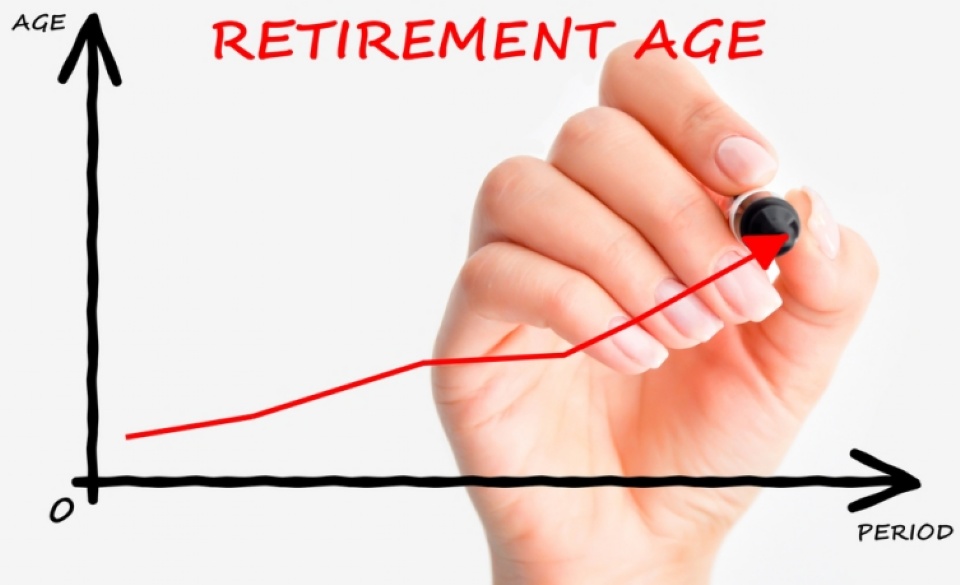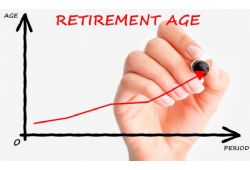The norms of retirement are
undergoing a Canada-wide shift. A recent survey released by HBSC shows that
Canadians are increasingly delaying full retirement by continuing to work. The
survey drew from a pool of 16,000 working and retired people in 15 countries
and regions, including 1,000 Canadians.
Over half of Canadians stated that they
intend to transition into full retirement by working for a diminished number of
hours, or to only retire once their health renders them unfit to continue work.
45<>percentage<> of working-age Canadians stated they anticipated a transitional phase of
“semi-retirement” before embracing full retirement. These findings point to a
shift in the norms of retirement primarily attributable to the growing records
of debt among Canadian seniors, and the values and lifestyles of the aging baby
boomer generation, boasting record highs of health and well-being levels. These
baby boomers are ushering in a new age of retirement, reinventing the leading image
and assumptions about the lifestyles and capabilities of seniors.
Today’s seniors live in an age of
improved health care, nutrition, exercise and awareness, helping them live
longer and collectively re-frame retirement as a time of mental and physical productivity.
Speaking to the leaps in Canadian life expectancy, the 2011 census identified
5,825 Canadians who had reached their 100th birthday. This number is
projected to rise to a grand total of 78,300 in the upcoming 50 years. Further
attesting to the momentum of health-related improvements, the median age in Canada
in 1961 was 26.3, a statistic that rose to 40.6 in the 2011 census. Marc
Freedman, author of Prime Time; How Baby
Boomers Will Revolutionize Retirement and Transform America, now describes modern
day retirement as a second stage of adulthood, marked by “purpose, contribution
and commitment, particularly to the well-being of the future...” Freedman’s
statement summarizes the emerging collective sentiment that retirement is being
reinvigorated of its old connotations.
In Quebec, it is projected that the
total population of people aged 65 or older will increase from 16<>percentage<> of the
provincial population to 26<>percentage<> by 2013. This means there will be an additional
one million seniors, shifting the age pyramid in significant proportions. Quebec
was the first jurisdiction in Canada to implement progressive measures for
phased retirement with the Supplemental Pensions Plans Act of 1997. The Act
permitted workers to diminish their working hours, while continuing to reap
pension benefits to add to their income. This gave rise to a general sense of
flexibility for retirement options in Quebec.
Limited finances have significantly
figured in the rising number of the semi-retired who increasingly struggle to
fund a full retirement. 12<>percentage<> of respondents in HBSC’s survey disclosed that they
simply could not afford to retire full time. This corresponds with findings in
a March 2015 Statistics Canada survey, revealing that the ratio of household
debt to disposable income had reached an alarming high by 2014; households were
found to owe roughly $1.63 in consumer credit, mortgage, and non-mortgage loans
per dollar of their disposable income. These record levels of debt have been
attributed to prolonged periods of low interest rates that have lured people to
engage in borrowing, while driving up home prices – both to which many seniors
are subjected.
However, decisions to semi-retire
can also be determined by the sheer desire to stay active throughout retirement.
38<>percentage<> of respondents decided to semi-retire because they simply did not want
immediate retirement, while 37<>percentage<> stated they wanted to remain physically and
mentally fit. Of further importance to
semi-retirees and senior workers is the social interaction and sense of purpose
that they can access through the workplace. Many respondents stated that they derived a great deal of pleasure and
satisfaction from work. In response, many employers now actively call
upon baby boomers for their experience and expertise in the workforce as
concerns about labor shortages arise from slowdowns in population growth.
Despite these
national statistics, it has been found that Quebeckers tend to proceed more
quickly into full retirement than Canadians. Between 1991 and 2001, studies
found that 81<>percentage<> of Quebec’s new retirees left the workplace immediately, while
19<>percentage<> pursued a transition phase. Furthermore, in Quebec, people between the age
of 55 and 64 engaged in the labor force constitute 52<>percentage<>, while the national
average stands at 61<>percentage<>. However, this is
not to say that Quebec’s senior demographic does not stay active by other
means. Active adult homes are an increasingly popular option, designed to cater
to the healthful stamina of the baby boomers. These homes include fitness
centres, sports complexes and lounges that create a community feeling.
Furthermore, 88<>percentage<> of seniors have chosen to stay in their home after retiring.
This indicates that seniors continue to value autonomy and a commitment to
their community in their retirement.
While statistics reveal the financial precariousness of seniors
as they struggle to support themselves, they might also usher in a welcome
shift in understandings of what retirement means. Retiring, or semi-retiring, is
increasingly allowing people to review and re-purpose the connotations of
retirement, conceptually re-framing it as a time to develop one’s passion, or meaningfully
participate in a broader community as in the workplace. Debt aside, the latest
findings about the desire to semi-retire are forging a re-conceptualization of
retirement as a time of stimulation, purpose and discovery.
Sources
http;//news.nationalpost.com/news/canada/canadas-aging-boomers-are-placing-new-strain-on-business-government
https;//encore.org/books-marc-freedman/
http;//www.iedm.org/files/juin07_en_0.pdf
http;//static1.1.sqspcdn.com/static/f/633158/9530586/1290462691613/Bourhis+publication.pdf?token=jzozJq1yI0xW<>percentage<>2Fr65fcFscYlYw7g<>percentage<>3D
https;//www.mfa.gouv.qc.ca/fr/publication/Documents/politique-vieillir-et-vivre-ensemble_English_version.pdf
http;//www.budget.finances.gouv.qc.ca/Budget/2012-2013/en/documents/seniors.pdf

 In The Latest Issue:Latest Issue:
In The Latest Issue:Latest Issue:
- A Bittersweet Farewell
- The new Laval Aquatic Co...
- The End of an Era:
Articles
Calendar
Virtual- ANNUAL TEACHER APPRECIATION CONTEST
- APPUI LAVAL
- ARTS & CULTURE
- CAMPS
- CAR GUIDE
- CCIL
- CENTENNIAL ACADEMY
- CHARITY FUNDRAISING
- CITYTV
- COSMODÔME
- COMMUNITY CONNECTIONS
- COVER STORY
- DINA DIMITRATOS
- ÉCOLE SUPÉRIEURE DE BALLET DU QUÉBEC
- EDITORIALS
- ÉDUCALOI
- EDUCATION
- EMPLOYMENT & ENTREPRENEURSHIP
- FÊTE DE LA FAMILLE
- FÊTE DU QUARTIER SAINT-BRUNO
- FAMILIES
- FESTIVAL LAVAL LAUGHS
- FÊTE DE QUARTIER VAL-DES-BRISES
- FINANCES
- GLI CUMBARE
- GROUPE RENO-EXPERT
- HEALTH & WELL-BEING
- 30 MINUTE HIT
- ANXIETY
- CHILDREN`S HEALTH & WELLNESS
- CLOSE AID
- DENTAL WELLNESS
- EXTREME EVOLUTION SPORTS CENTRE
- FONDATION CITÉ DE LA SANTÉ
- GENERAL
- HEARING HEALTH
- MESSAGES FROM THE HEALTH AGENCY OF CANADA
- MENTAL HEALTH
- SEXUALITY
- SOCIAL INTEGRATION
- SPECIAL NEEDS
- TEENS
- THE NUTRITION CORNER
- THE NUTRITION CORNER - RECIPES
- VACATION DESTINATION
- WOMEN'S FITNESS
- WOMEN'S HEALTH
- HILTON MONTREAL/LAVAL
- HOME & GARDEN
- INTERNATIONAL WOMEN'S DAY
- JAGUAR LAVAL
- LAVAL À VÉLO
- LAVAL FAMILIES TV SHOW
- LAVAL FAMILIES MAGAZINE CARES
- LAVAL URBAN IN NATURE
- LE PARCOURS DES HÉROS
- LES PETITS GOURMETS DANS MA COUR
- LEON'S FURNITURE
- LEONARDO DA VINCI CENTRE
- LFM PREMIERES
- LIFE BALANCE
- M.P. PROFILE
- MISS EDGAR'S AND MISS CRAMP'S SCHOOL
- MISSING CHILDREN'S NETWORK
- NETFOLIE
- NORTH STAR ACADEMY LAVAL
- OUTFRONT MEDIA
- PASSION SOCCER
- PARC DE LA RIVIÈRE-DES-MILLE-ÎLES
- PÂTISSERIE ST-MARTIN
- PIZZERIA LÌOLÀ
- PLACE BELL
- PORTRAITS OF YOUR MNA'S
- ROCKET DE LAVAL
- SACRED HEART SCHOOL
- SCOTIA BANK
- SHERATON LAVAL HOTEL
- SOCIÉTÉ ALZHEIMER LAVAL
- STATION 55
- STL
- SUBARU DE LAVAL
- TECHNOLOGY
- TEDXLAVAL
- TODAY`S LAURENTIANS AND LANAUDIÈRE
- TODAY`S LAVAL
- WARNER MUSIC
- THIS ISSUE
- MOST RECENT
Magazine
Reinventing Retirement: Seniors Going Back to Work
Articles ~e 105,7 Rythme FM 4 chemins Annual Teacher Appreciation Contest Appui Laval Arts & Culture Ballet Eddy Toussaint Camps THIS ISSUE MORE...
CONTESTS Enter our contests
CONTESTS Enter our contests
CALENDAR
Events & Activities
COMMUNITY Posts Events
PUBLICATIONS Our Magazine Family Resource Directory
LFM BUSINESS NETWORK Learn more
COUPONS Click to save!
COMMUNITY Posts Events
PUBLICATIONS Our Magazine Family Resource Directory
LFM BUSINESS NETWORK Learn more
COUPONS Click to save!
SUBSCRIPTIONS
Subscribe to the magazine
Un-Subscribe
E-NEWSLETTER Subscribe to our E-newsletter Un-Subscribe
WRITE FOR US Guidelines & Submissions
POLLS Vote today!
E-NEWSLETTER Subscribe to our E-newsletter Un-Subscribe
WRITE FOR US Guidelines & Submissions
POLLS Vote today!
ADVERTISERS
How to & Media guide
Pay your LFM invoice
SUGGESTIONS Reader's Survey Suggest a Listing
LFM About Us Our Mission Giving Back Contact Us
SUGGESTIONS Reader's Survey Suggest a Listing
LFM About Us Our Mission Giving Back Contact Us
 PICK-UP LOCATIONS
Get a copy of LFM!
PICK-UP LOCATIONS
Get a copy of LFM!
TERMS & CONDITIONS Privacy | Terms
ISSN (ONLINE) 2291-1677
ISSN (PRINT) 2291-1677
Website by ZENxDESIGN



 BY:
BY: 
Tweet
Share